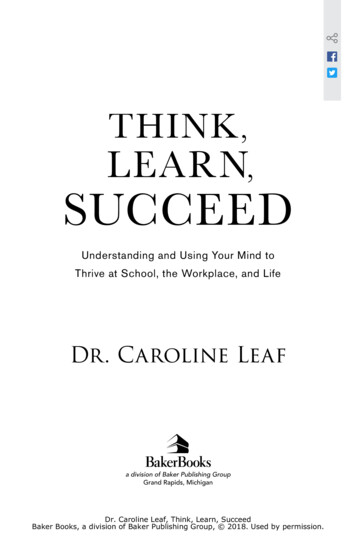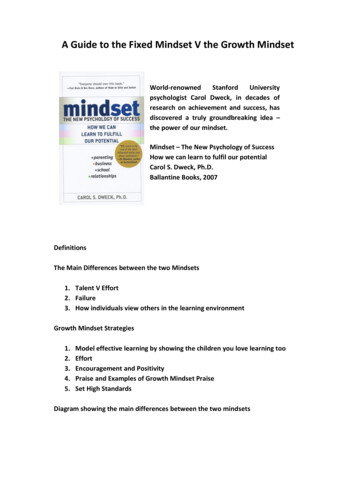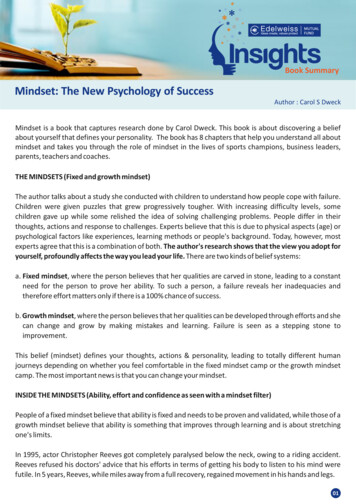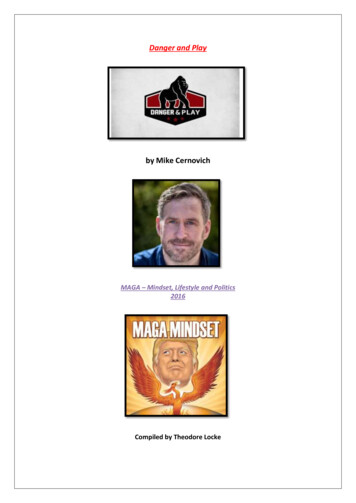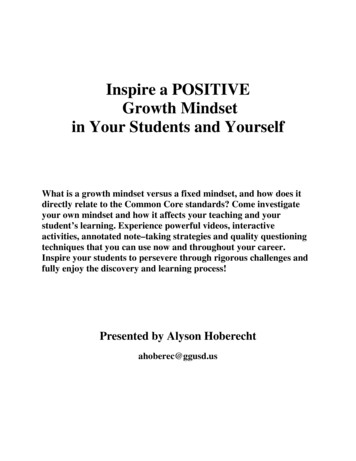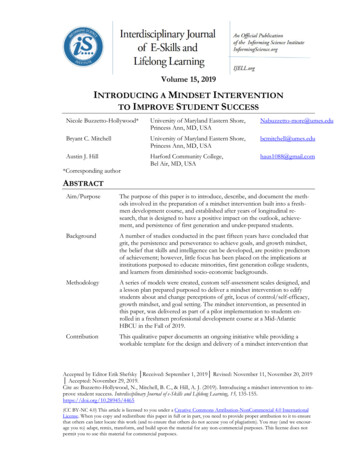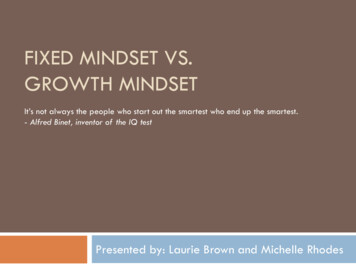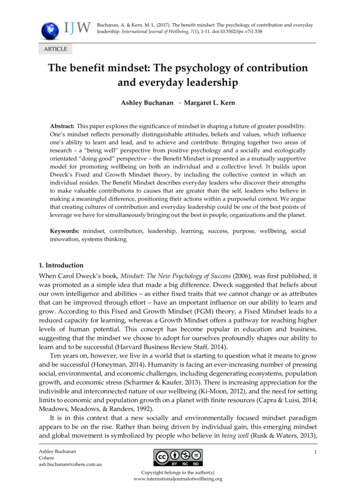
Transcription
Buchanan, A. & Kern, M. L. (2017). The benefit mindset: The psychology of contribution and everydayleadership. International Journal of Wellbeing, 7(1), 1-11. doi:10.5502/ijw.v7i1.538ARTICLEThe benefit mindset: The psychology of contributionand everyday leadershipAshley Buchanan · Margaret L. KernAbstract: This paper explores the significance of mindset in shaping a future of greater possibility.One’s mindset reflects personally distinguishable attitudes, beliefs and values, which influenceone’s ability to learn and lead, and to achieve and contribute. Bringing together two areas ofresearch – a “being well” perspective from positive psychology and a socially and ecologicallyorientated “doing good” perspective – the Benefit Mindset is presented as a mutually supportivemodel for promoting wellbeing on both an individual and a collective level. It builds uponDweck’s Fixed and Growth Mindset theory, by including the collective context in which anindividual resides. The Benefit Mindset describes everyday leaders who discover their strengthsto make valuable contributions to causes that are greater than the self, leaders who believe inmaking a meaningful difference, positioning their actions within a purposeful context. We arguethat creating cultures of contribution and everyday leadership could be one of the best points ofleverage we have for simultaneously bringing out the best in people, organizations and the planet.Keywords: mindset, contribution, leadership, learning, success, purpose, wellbeing, socialinnovation, systems thinking1. IntroductionWhen Carol Dweck’s book, Mindset: The New Psychology of Success (2006), was first published, itwas promoted as a simple idea that made a big difference. Dweck suggested that beliefs aboutour own intelligence and abilities – as either fixed traits that we cannot change or as attributesthat can be improved through effort – have an important influence on our ability to learn andgrow. According to this Fixed and Growth Mindset (FGM) theory, a Fixed Mindset leads to areduced capacity for learning, whereas a Growth Mindset offers a pathway for reaching higherlevels of human potential. This concept has become popular in education and business,suggesting that the mindset we choose to adopt for ourselves profoundly shapes our ability tolearn and to be successful (Harvard Business Review Staff, 2014).Ten years on, however, we live in a world that is starting to question what it means to growand be successful (Honeyman, 2014). Humanity is facing an ever-increasing number of pressingsocial, environmental, and economic challenges, including degenerating ecosystems, populationgrowth, and economic stress (Scharmer & Kaufer, 2013). There is increasing appreciation for theindivisible and interconnected nature of our wellbeing (Ki-Moon, 2012), and the need for settinglimits to economic and population growth on a planet with finite resources (Capra & Luisi, 2014;Meadows, Meadows, & Randers, 1992).It is in this context that a new socially and environmentally focused mindset paradigmappears to be on the rise. Rather than being driven by individual gain, this emerging mindsetand global movement is symbolized by people who believe in being well (Rusk & Waters, 2013),Ashley BuchananCohereash.buchanan@cohere.com.au1Copyright belongs to the author(s)www.internationaljournalofwellbeing.org
The benefit mindsetBuchanan & Kernand doing good for our world (Hawken, 2007). It is a purpose-driven, leadership-based mindsetthat is redefining success: not only being the best in the world, but also being the best for theworld. It is what we call the Benefit Mindset.To support this position, we first consider mindset theory from an individual and a collectiveperspective. We recognize both the contribution that FGM has provided to our understanding oflearning and achievement, as well as its limitations in addressing our collective challenges.Second, we suggest that individually focused “being well” perspectives coming from positivepsychology complement the leadership and purpose focused “doing good” applications comingfrom socially and environmentally oriented communities and organizations. Finally, we proposethe Benefit Mindset – which is orientated towards collectively creating the future – as acomplementary evolution of FGM.2. Mindset theoryMindset can generally be defined as the underlying assumptions that shape a person’s ability toperceive and understand the world (McEwen & Schmidt, 2007). Mindset is a deep psychologicalconstruct that underpins our personally distinguishable attitudes, beliefs, and values (Schein,2015). It influences our “everyday” behaviors and actions (Senge, 1990), our ability to learn(Dweck, 2006), and has a cascading, self-fulfilling effect on reality (Crum et al., 2011; Crum &Langer, 2007). This means that there is no way to avoid the subconscious influence of our mindset(Bohm & Edwards, 1999). The mindset we adopt for ourselves acts like a puppet master, pullingthe “everyday” strings of our future possibilities on both individual and a collective levels(Clifton, 2013).With appropriate ability and conditions, we can consciously shift our mindsets. At anindividual level, creating shifts in our mindset and beliefs can promote long-term improvementsin wellbeing and resilience (e.g., Vella-Brodrick, 2013). Personal shifts also impact outcomes atthe collective level. Indeed, Meadows (1999) suggested that the most powerful and influentialwhole-system lever is the mindset out of which a system arises. She states that mindsets are theunderlying sources of systems, and small shifts in our mindsets can produce big systemicchanges. Thus, mindset is an individual characteristic that offers great potential at creatingchange at both individual and collective levels. Being able to co-discover how mindsets manifestthemselves, while being open and able to shift them, is the essence of creating profound personaland whole-system change (Brown, 2005; Hochachka, 2005; Scharmer, 2009).Although mindset has been studied by numerous scholars across multiple disciplines (e.g,.McEwen & Schmidt, 2007; Meadows, 1999; Schein, 2015), Dweck’s FGM theory has received themost attention within various sub-disciplines of psychology. Dweck’s mindset researchspecifically focuses on how beliefs around the nature of one’s intelligence impacts a person’sability to learn, accomplish their goals, and reach their potential (Dweck, 2006). By limiting thetheory’s focus to beliefs on intelligence and learning, it has enabled numerous studies on therelationship between mindset and accomplishment. However, this limited focus generallyneglects the broader contextual implications of mindset.The major implication of this limited focus is that it overly encourages people to think aboutwhat they do (Fixed Mindset) and how they do it (Growth Mindset), rather than the broaderquestion of why they do something. This leads to a tendency for individuals to repeat the patternsof the past, rather than bringing about what could be different and meaningful in the world.In effect, Dweck’s framework has isolated learning and accomplishment from the broadercontext of leadership and purpose. Given that today’s modern pursuit of success and growth isbelieved to be one of the main reasons for the global challenges we are facing in the world todaywww.internationaljournalofwellbeing.org2
The benefit mindsetBuchanan & Kern(Capra & Luisi, 2014), any framework that promotes learning and accomplishment withoutcontext is arguably a risky endeavor. By not specifically considering the larger socioenvironmental context, the FGM framework runs the risk of creating unintended consequencesfor our common future. From a societal perspective, rather than promoting “learning forlearning’s sake” and “accomplishment for accomplishment’s sake,” it is preferable to have amindset framework that encourages people to think about why they do what they do, and howthey can make valuable contributions to the collective good.This is not to say that learning and the pursuit of accomplishment should not be encouraged.The human drive to learn, achieve and realize our visions is one of the most powerful tools wehave for creating the future (e.g., Ryan & Deci, 2000). However, if we want to create the bestfuture possibility for all of humanity, then such motivations should be situated within apurposeful and collective context (Clifton, 2015; Cooperrider & Whitney, 2005).3. Moving beyond the FGMOver the past few decades, three areas of research and application have emerged that areenriching what it means to reach one’s potential, and more explicitly positioning an individual’sdevelopment and contributions within a purposeful and collective context. These are the beingwell movement, the doing good movement, and the leadership maturity framework.3.1 The being well movementUnder the umbrella of positive psychology, there is growing interest in what could be called thebeing well movement. The field seeks to explore what is right with people, to identify activitiesand interventions that build a personal sense of wellbeing, and to gain a more scientificallyrigorous picture of what constitutes the optimal functioning of individuals, groups, andinstitutions (Boniwell, 2012; Seligman & Csikszentmihalyi, 2000). Core to this perspective isunderstanding the psychological traits that empower people to operate at the peak of theirpotential, such as discovering their strengths (e.g., Park, Peterson, & Seligman, 2004),experiencing and sharing positive emotions (e.g., Fredrickson, 2004), participating in satisfyingrelationships (e.g., Gottman & Silver, 2015), being psychologically engaged and interested in lifetasks (e.g., Csikszentmihalyi, 1990), and having a sense of meaning and purpose in life (e.g.,Steger et al, 2008).Whereas early scholarship focused primarily on hedonic wellbeing (i.e., feeling good, with afocus on emotion), the past decade has increasingly seen a shift toward more sophisticatedmodels of wellbeing (e.g., Huppert & So, 2013; Ryff & Singer, 1998; Seligman, 2012). Notably,although much of the focus has been on individual subjective wellbeing, there is a growing callto turn to more collective and whole system conceptualizations (e.g., Boston Consulting Group,2015; Ki-Moon, 2012). Studies are increasingly considering wellbeing in the workplace (e.g.,Cameron & Dutton, 2003), in schools (e.g., Oades, Robinson, & Green, 2011; Waters & White,2015), and in communities (e.g., Cooperrider & Fry, 2012; Seligman, 2013).One of the goals of this movement is to see a greater proportion of the world’s populationflourishing (e.g., Seligman, 2012). The pursuit of this goal is leading to the realization that humanflourishing is best thought of, not as an individual activity, but rather, as something we must dotogether (e.g., Ki-Moon, 2012). This goal must be approached on both an individual and acollective level if we want to live in a flourishing global society. As a result, this being wellmovement is fundamentally enriching our appreciation of what it means to reach our potentialbeyond learning and achievement, and it is helping populations widen their circle of compassionto encompass our collective ability to flourish.www.internationaljournalofwellbeing.org3
The benefit mindsetBuchanan & Kern3.2 The doing good movementWhat if the aim of every person, every organization, and every act of development was to be aforce for good? In what is being called the doing good movement (Hawken, 2007), companies,communities, policies, and several areas of study are doing just that. International groups suchas B-Corporation (Honeyman, 2014) and Conscious Capitalism (Mackey & Sisodia, 2014) havebeen helping organizations all over the world return shareholder value and purposefully benefitthe common good (Felbe, 2015; Sisodia, Sheth, & Wolfe, 2014). Practices such as Social Labs(Hassan, 2014) and Collective Impact (Kania & Kramer, 2011) are helping communities facilitatelarge-scale social change and improvements. At the highest level, policies and measures like theGlobal Goals (www.globalgoals.org) have been developed to guide everyone towards asustainable future.At the heart of this doing good movement are people leading with purpose (Hurst, 2014),people who share a deep motivation to be of value to the systems to which they belong (Edwards,2015; Brown, 2011). These leaders believe in making generative contributions to society, theenvironment, and the economy – thinking about me and we (Hollender, 2015; Scharmer & Kaufer,2013).What is becoming clear to the leaders of this movement is that it is not enough to addressdoing good through externally focused initiatives alone. In order to change the world externally,we need to be also willing to change ourselves internally by shifting our mindsets (e.g., Bohm &Edwards, 1991; Reed, 2007; Scharmer, 2009). In particular, it has been suggested that we need tocultivate a willingness to work collectively, learning how to access a deeper level of our humanity(Heifetz, Grashow & Linsky, 2009; Scharmer & Kaufer, 2013), from being learners and achieverswho are focused on doing things better to being leaders and contributors who are focused on doingbetter things.In summary, this doing good movement aspires to provide people with a richer appreciationof what it means to be of value – to themselves, to others, to nature and to the future.3.3 The Leadership Maturity FrameworkA third area that is enriching what it means to reach one’s potential, and positions an individual’sdevelopment within a collective context, is the human development literature. Building on EgoDevelopment Theory (Loevinger, 2014), the Leadership Maturity Framework (LMF; CookGreuter, 2013) describes different ways that adults make meaning at different levels ofdevelopmental maturity (see Table 1 below). As a person matures, their meaning-makingapproach, their mindset, and their action logic becomes more comprehensive and effective indealing with the complexities of life (Rooke & Torbert, 2005).The Fixed and Growth Mindsets can generally be seen to parallel the expert and achieverlevels of leadership maturity, respectively. Achievers have typically been found to only be ableto work within the systems to which they belong and do not question the system itself. However,the framework identifies higher levels of meaning-making maturity; this includes theindividualist and the strategist. The theory suggests that it is only when people mature to anindividualist level of leadership maturity that they can regularly maintain ecosystem awarenessand can lead the systems they are a part of, rather than just learn and achieve within the system.Thus, individualists have a significant advantage for questioning why they do what they do,challenging their underlying assumptions, and finding purpose beyond the accomplishment ofgoals. Making the shift from achiever to individualist thus represents the beginning of a shiftfrom being a learner and an achiever within a system to becoming a leader for the system.www.internationaljournalofwellbeing.org4
The benefit mindsetBuchanan & KernTable 1. Leadership Maturity Framework: Expert to strategist levels of leadership maturityMaturityStrategist%4% Key CharacteristicsEmbraces the tenets of an ecosystem worldviewDevelops lifetime purposeCommitted to creating ecosystem benefitGenerates organizational and personal transformationsIndividualist10% Able to shift from ego to ecosystem awarenessLooks at the status quo through multiple perspectivesAble to query their assumptions, values and beliefsBefore solving problems, figures out what the problem isAchiever30% Goal and ideal orientedContinues to grow and develop themselvesOften questions the “shoulds” in professional contextsIndependent, entrepreneurial and self-reliantExpert38% Interested in being successfulRuled by logic and expertiseHas a strong sense of what “should” and “ought” to beLikes to perfect their craftNote: Levels are organized hierarchically, with greater maturity at the top level (strategist) versus bottom(expert). Percentages of sample population by Rooke & Torbert, (2005). Characteristics noted by CookGreuter, (2013). This table is only a partial reproduction of the LMF. For the complete table, refer to CookGreuter and Rooke & Torbert.The potential for learning and leadership increases again once people shift to the strategist levelof maturity. Strategists are able to hold a world-centric perspective. They tend to focus ondeveloping a lifetime purpose, have been shown to be highly effective at leading organizationaland societal transformations (Brown, 2011), and generally commit to making a meaningfuldifference for all of their stakeholders.As a whole, the LMF highlights that reaching a world-centric perspective is the result ofinternal growth and transcendence (Esbjörn-Hargens, 2009), and that there are definable andtestable mindsets that are consistent with the FGM as well as the emerging being well and doinggood movements.4. The Benefit MindsetTo reflect this emerging mindset paradigm, we propose an extension to the FGM framework:The Benefit Mindset (Figure 1 below). The Benefit Mindset framework highlights some of theimportant distinctions we have noted: between learning and leadership, and betweenachievement and contribution. The definition specifically includes the term “everyday” becauseof the ever-present puppet master effect our mindsets have on the lives we lead, the actions wetake, and the future possibilities of the world we live in. As a practical example, Figure 2 belowprovides a case study of an everyday leader.www.internationaljournalofwellbeing.org5
The benefit mindsetBuchanan & KernFigure 1. Comparing the Fixed, Growth and Benefit MindsetsFigure 2. Marva Collins: An everyday leader case study (adapted from Roberts, 2015)Marva Collins is an American teacher who was raised with the “expectation to be excellent.”However, in the 1970s, she worked in a school system where the inadequacies associated withAfrican-American education appalled her. Marva lived at a time when students were labelledas “unteachable” or as having impossible-to-overcome learning disabilities if they did not fitinto the normal education system. Whereas most teachers tried to get the most out of thisexisting system, Collin’s questioned the purpose of the system itself. She decided to put hervalues in action, cashed in her 5,000 pension, and started a new school for any child who’dbeen failed by the school system. The school was especially for those diagnosed withimpossible-to-overcome learning disabilities. Facing tough odds, she learned to embody hervalue of “believing in the children” and famously transformed the lives of thousands ofunderprivileged students. After the first year, every student in her class tested five gradelevels higher. Collins not only taught the unteachable, she inspired a whole new generationof teachers. In 1980, Ms. Collins was recognised for her contributions, being asked to becomethe Secretary of Education in the U.S. Government.This proposed evolution is not to suggest that concepts such as the FGM are less important. Onthe contrary, learning how to grow, achieve and differentiate ourselves through deliberatepractice is integral to every person’s development. The Benefit Mindset simply positions humandevelopment and effort within a collective and purposeful context. By explicitly extending theFGM framework in this way, we provide a richer definition of what it means to learn and lead –to achieve and collectively contribute.From this perspective, the key question these everyday leaders ask themselves is not howthey can flourish in isolation, but rather, how we can all come together and become partners ineach other’s flourishing. They recognize that our ability to flourish is deeply interrelated withthe communities and ecosystems to which we belong.www.internationaljournalofwellbeing.org6
The benefit mindsetBuchanan & KernFinally, there is an interesting dynamic that can be seen here that is worth discussing.Although studies and applications across the being well and doing good movements have occurredin different domains, we suggest that the two are mutually supportive. The more well you are,the greater your capacity for doing good. And the more good you do, the greater your capacityfor being well. Being well and doing good are quite likely interconnected enablers of each other.The existence of such a virtuous relationship is supported by numerous findings, includingtheories of resilience (Reivich & Shatté, 2002), self-determination theory (Ryan & Deci, 2000) thebenefits of altruism (Post, 2005; Ricard, 2015), and post-ecstatic growth theory (Roepke, 2013).5. ImplicationsThe great value we see in this extension of the FGM is in how it can help people think about theinterwoven nature of human and ecological flourishing. The Benefit Mindset is a powerful toolfor talking about the role that mindset plays in purposefully creating the future. It is somethinganyone can do, regardless of position or status, to make a meaningful difference.Additionally, this extension to the FGM has implications across multiple fields, most notablyeducation, business and psychology, which we offer as a few examples, but encourage readersto consider specific applications to their own respective domains.5.1 EducationMany education systems globally are over-emphasizing academic performance, and oftenneglect the potential of internal development (e.g., Palmer, Zajonc, & Scribner, 2010). The BenefitMindset framework provides students with a richer perspective of human potential and internaldevelopment. It can help students integrate learning and leadership, achievement andcontribution at an early age. It also could have significant impacts in shifting students’ awarenessto include me and we, and in empowering youth to become purposeful future makers.5.2 BusinessIt has been suggested that the future belongs to businesses with purpose (Honeyman, 2014;Hurst, 2014). Developing everyday leaders with a Benefit Mindset could be one of the best waysto truly embed purpose and everyday leadership into business operations. A growing numberof people only want to work for purpose-driven organizations (Bailey, 2015), and the BenefitMindset offers strategic value for attracting and supporting the development of people in usingbusiness as a force for good and in promoting cultures of human flourishing.5.3 PsychologyMuch of psychology focuses on what is within the person or on how aspects of the social contextinfluence a person’s behavior. The Benefit Mindset challenges psychologists to develop moresophisticated contextual perspectives of wellbeing, leadership, and human potential. It alsochallenges researchers to explore psychological pathways for shifting mindsets beyond growth.While there is clarity on how to shift from a Fixed to Growth Mindset, how do we helpindividuals and organizations cultivate a Benefit Mindset?6. Further workThis paper is just the beginning of a broader conversation on the importance of mindset inshaping a future of greater possibility, and further research is needed to develop the thesispresented in this paper.www.internationaljournalofwellbeing.org7
The benefit mindsetBuchanan & KernWe offer a challenge to the social sciences to explore the potential of the Benefit Mindset.Research questions could include: How does contribution impact individual wellbeing andpromote collective flourishing? How does mindset empower people to widen their circle ofcompassion? What are the enablers and barriers to developing a Benefit Mindset? How might aschool, business or sustainability project benefit from purpose-driven mindset development?What are the broader economic, societal, and ecological implications of a culture of contributionand everyday leadership? Does the level of application (e.g., individual, organizational, societal)influence outcomes? How do we best measure and quantify the scale and quality of benefitcreated?While “being well” and “doing good” may sound reasonable, the words “well” and “good”involve a value judgment. How do we decide what “well” and “good” are? If it is beneficial tohumanity, then people ought to be a part of defining what that well and good are. This level ofmoral and ethical complexity creates the need for dialogue between an increasing diversity ofstakeholders. In addition, the definition of “benefit” may evolve over time and across cultures,depending upon the morals and values of the people themselves. Further work around culturalinterpretations and definitions of the Benefit Mindset is needed.7. ConclusionWhile we can aspire to create a future of greater possibility, there is a case to be made that it isonly going to be systemically possible if we also consider the ever-present influence of mindset.The Benefit Mindset is presented as a complementary evolution of Dweck’s Fixed and GrowthMindsets, highlighting the important distinctions between learning and leadership, and betweenachievement and contribution. We argue that creating cultures of the Benefit Mindset could beone of the best points of leverage we have for simultaneously bringing out the best in people,organizations, and the planet as a whole. We hope that by defining this mindset paradigm, it willimprove our collective understanding and provide psychological visibility of how our everydayleaders are creating profound personal and whole systems change.AuthorsAshley BuchananCohereash.buchanan@cohere.com.auMargaret L. KernThe University of Melbournepeggy.Kern@unimelb.edu.auPublishing TimelineReceived 9 June 2016Accepted 23 November 2016Published 9 June 2017ReferencesBailey, M. (2015, November 17). It’s hip to B corp, but it’s not exactly legal [Blog post]. BRW Online.http://www.brw.com.au/p/business/it hip to corp but it not exactly llbeing.org8
The benefit mindsetBuchanan & KernBan, K-M. (2012). Secretary-General’s remarks at high level meeting on “Happiness and well-being:Defining a new economic paradigm.” http://www.un.org/sg/STATEMENTS/index.asp?nid 5966Beal, D., Rueda-Sabater, E., & Heng, S. L. (2015). Why well-being should drive growth strategies: The2015 sustainable economic development assessment. Boston Consulting economic-development-assessment/Bohm, D., & Edwards, M. (1991). Changing consciousness: Exploring the hidden source of the social, politicaland environmental crises facing our world. San Francisco, CA: Harper Collins.Boniwell, I. (2012). Positive psychology in a nutshell: The science of happiness. London, United Kingdom:McGraw-Hill Education.Brown. B. C. (2005). Theory and practice of integral sustainable development. Part 2: Values,developmental levels, and natural design. AQAL Journal of Integral Theory and Practice, 1(2), 2-39.Brown, B. C. (2011). Conscious leadership for sustainability: How leaders with a late-stage action logic design andengage in sustainability initatives (Doctoral dissertation). Fielding Graduate University. ProquestDissertations & Theses (Accession Order No. 3498378).Cameron, K. S., Dutton, J. E., & Quinn, R. E. (2003). Positive organizational scholarship: Foundations of a newdiscipline. San Francisco, CA: Berrett-Koehler.Capra, F. (1996). The web of life: A new scientific understanding of living systems. New York, NY: Anchor.Capra, F., & Luisi, P. L. (2014). The systems view of life: A unifying vision. Cambridge, United Kingdom:Cambridge University Press. https://doi.org/10.1017/CBO9780511895555Clifton, J. (2013). Thirteen universal assessments which may contribute to the ‘good life’ (Unpublished mastersthesis). University of Pennsylvania. Scholarly t.cgi?article 1041&context mapp capstoneClifton, J. (2015). Positive psychology. uter, S. (2013). Nine levels of increasing embrace in ego development: A full-spectrum theory ofvertical growth and meaning making. Zugriff am, 18, 2015.Cooperrider, D. L., & Fry, R. (2012). Mirror flourishing and the positive psychology of sustainability.Journal of Corporate Citizenship, 46, 3-12. operrider, D. L., & McQuaid, M. (2012). The positive arc of systematic strengths: How appreciativeinquiry and sustainable designing can bring out the best in human systems. Journal of CorporateCitizenship, 46, 71-102. operrider, D., & Whitney, D. D. (2005). Appreciative inquiry: A positive revolution in change. SanFrancisco, CA: Berrett-Koehler.Crum, A. J., Corbin, W. R., Brownell, K. D., & Salovey, P. (2011). Mind over milkshakes: Mindsets, notjust nutrients, determine ghrelin response. Health Psychology, 30(4), 424-429.https://doi.org/10.1037/a0023467Crum, A. J., & Langer, E. J. (2007). Mind-set matters: Exercise and the placebo effect. Psychological Science,18(2), 165-171. ikszentmihalyi, M. (1990). Flow: The psychology of optimal experience. New York, NY: Harper & Row.Duke, N. N., Skay, C. L., Pettingell, S. L., & Borowsky, I. W. (2009). From adolescent connections to socialcapital: Predictors of civic engagement in young adulthood. Journal of Adolescent Health, 44(2), 161168. eck, C. S. (2006). Mindset: The new psychology of success. New York, NY: Random House.Dweck, C. S. (2007). Boosting achievement with messages that motivate. Education Canada, 47(2), 6-10.Edwards, A. R. (2015). The heart of sustainability: Restoring ecological balance from the inside out. GabriolaIsland, BC: New Society.Esbjörn-Hargens, S. (2009). Integral ecology: Uniting multiple perspectives on the natural world. Boston,Massachuse
When Carol Dweck’s book, Mindset: The New Psychology of Success (2006), was first published, it was promoted as a simple idea that made a big difference. Dweck suggested that beliefs abo
